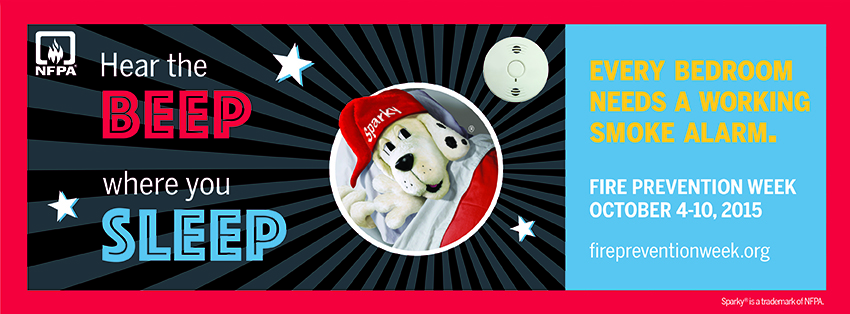Tag Archives: FPW
It’s Fire Prevention Week!
Hear the Beep Where You Sleep
If I asked you where your smoke alarms are in your home, could you tell me? If you’re like many people, you may not pay much attention to where smoke alarms have been installed. However, location matters when it comes to smoke alarms.
Smoke alarms should be installed inside each bedroom, outside each sleeping area and on every level of the home, including the basement.
Working smoke alarms are a critical fire-safety tool that can mean the difference between life and death in a home fire. According to the nonprofit National Fire Protection Association (NFPA), smoke alarms can cut the chance of dying in a home fire in half. Meanwhile, NFPA data shows that home fires killed 2,755 people in 2013, an average of eight people every day that year. Many of these deaths could have been prevented with the proper smoke alarm protection.
As a member of the fire service for over 20 years, I’ve seen the devastating effects of fire first-hand; the burn injuries, the loss of homes and possessions are distressing. What’s even worse is witnessing a family’s anguish after a loved one has been killed in a fire. It’s heartbreaking.
As the official sponsor of Fire Prevention Week, October 4-10, 2015, NFPA is promoting “Hear the Beep Where You Sleep. Every Bedroom Needs a Working Smoke Alarm!” to better educate the public about the true value of working smoke alarms in the bedroom. In support of these efforts, San Carlos Park Fire District will be hosting educational activities throughout the whole month of October.
My sincere hope is that all San Carlos Park residents and make sure there are working smoke alarms installed throughout their homes. These simple steps can help make a life-saving difference, and prevent the potentially life-threatening impact of fire.
Here are additional smoke alarm tips to follow:
1. Install smoke alarms in every bedroom, outside each separate sleeping area and on every level of the home, including the basement.
2. Interconnect all smoke alarms throughout the home. When one sounds, they all sound.
3. Test alarms each month by pushing the test button.
4. Replace all smoke alarms, including alarms that use 10-year batteries and hard-wired alarms, when they are 10 year old or sooner if they do not respond properly.
5. Make sure everyone in the home knows the sound and understands what to do when they hear the smoke alarm.
6. If the smoke alarm sounds, get outside and stay outside.
Go to your outside meeting place. Call the fire department from outside the home.
To learn more about Fire Prevention Week the visit NFPA’s Web site at www.firepreventionweek.org.
Yours in Service,
Fire Chief David Cambareri

